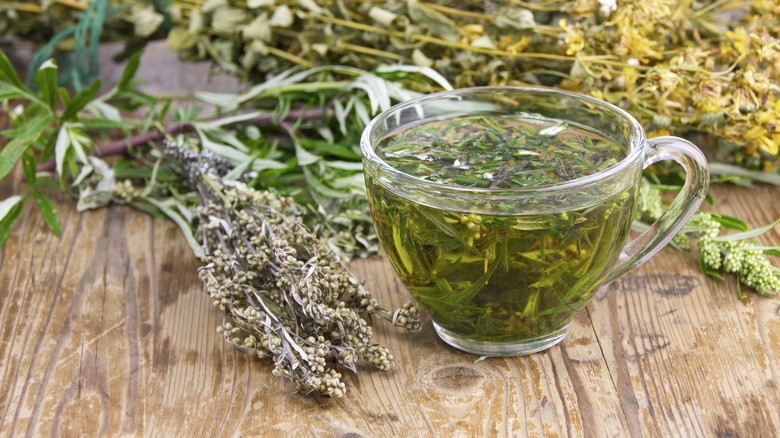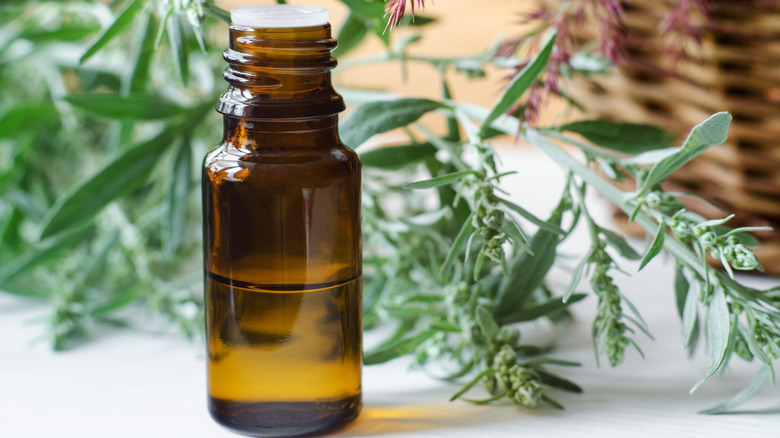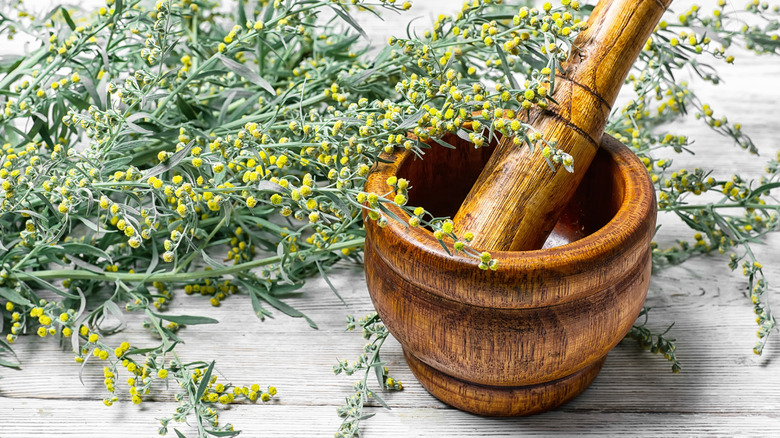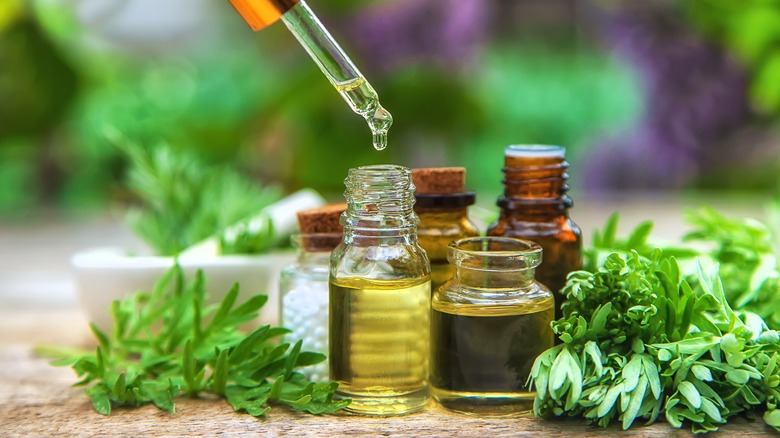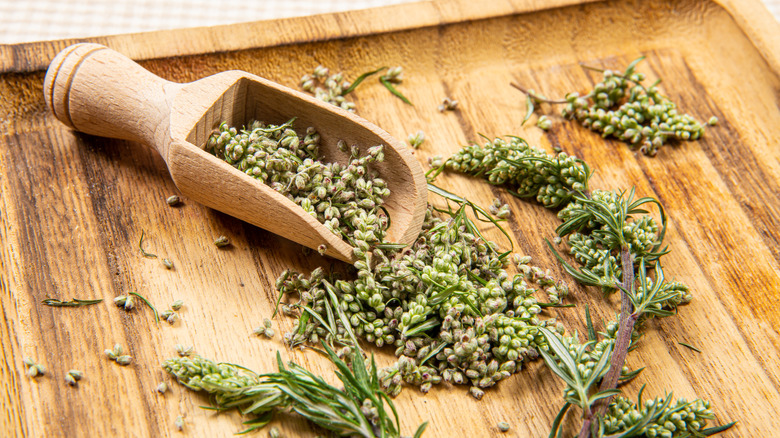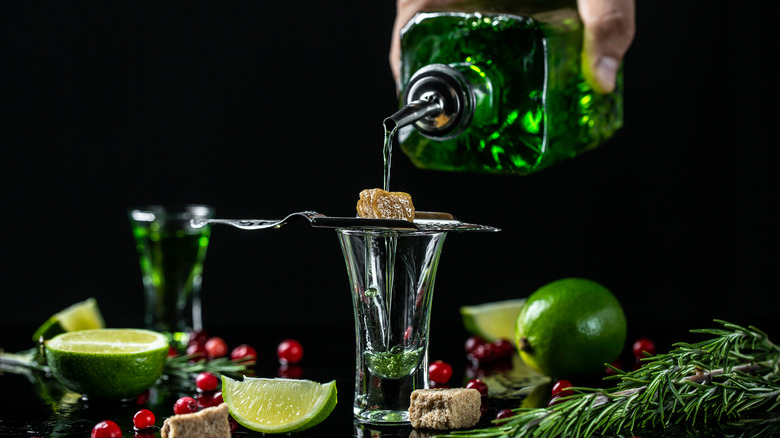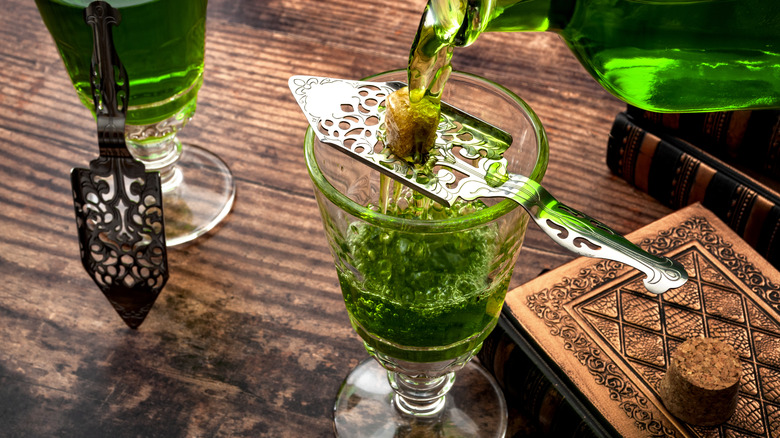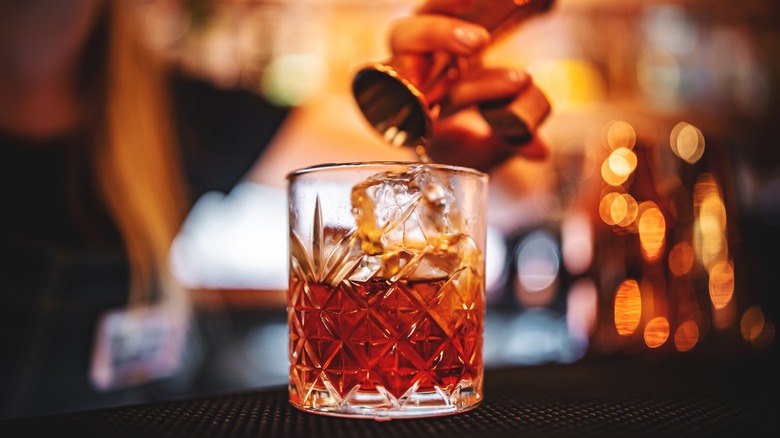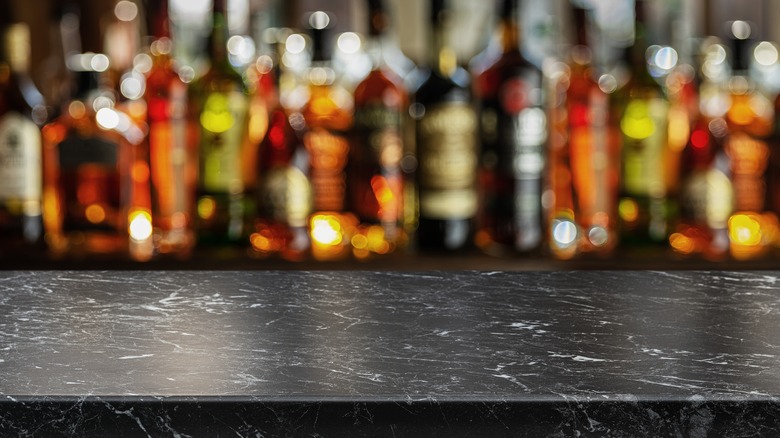8 Things You Never Knew About Wormwood
The very word "wormwood" seems to evoke witchcraft – or at the very least, something ancient and perhaps sinister. Indeed, the bitter herb, native to Europe, was historically used in witchcraft and was thought to increase psychic abilities as well as summon the spirits of the dead. But today, most know wormwood as a key ingredient in absinthe, a once-beloved, but later notorious, licorice-flavored spirit.
Absinthe became the drink of choice in Europe in the mid-19th century, when outbreaks of phylloxera, a type of aphid, decimated the continent's wine grape crops and forced drinkers to seek other alternatives. It became so popular that an entire subculture evolved around it. In Paris, the 5 o'clock happy hour became known as l'heure verte, or "the green hour," after absinthe's naturally green color. Drinkers devised a complex ritual for preparing it, slowly dripping water into their absinthe glasses through special slotted spoons, which held lumps of sugar that would gradually dissolve into the drink. But reports of seizures and sickness caused by absinthe spread with its popularity, and scientists of the time blamed the toxic effects of wormwood. By the 20th century, absinthe had been banned in most countries, including the U.S. (the ban was only lifted in 2007). Today's absinthe (and the small amount of wormwood it contains) is just as safe as any other spirit – but the mystique of wormwood lives on.
Wormwood's active ingredient, thujone, can be dangerous
Worried scientists in the 19th century had some reason to be wary of the wormwood in absinthe. Wormwood had long been used as a disinfectant and insect repellant, among other uses, so it was reasonable to suspect it could have some effect on people who consumed it in absinthe, especially if indulging in the popular drink was a regular habit.
Today it's known that the active ingredient in wormwood oil, thujone, affects the nervous system and can cause seizures and other neurological issues if consumed in sufficient quantities, per WebMD. It can also shorten attention spans, slow reaction times, and in some cases, cause hallucinations. Still, wormwood continues to be a popular herbal remedy for digestive and menstrual disorders, although modest doses are advised, according to the University of Texas at El Paso. But if you're concerned about the possible risks of thujone but still curious to try absinthe, you have no need to worry: The absinthe now legally sold in the U.S. is made with thujone-free wormwood oil and can legally contain no more than ten parts per million of thujone. So if you try it and still find your head spinning, you can blame the alcohol, not the wormwood.
Wormwood gets its name from its historical use as a dewormer
Wormwood did not, in fact, get its name from a reputation for being wormy or attracting worms. Instead, it got its name for its ability to get rid of intestinal worms, in both people and humans. Early Germanic medical texts note that the intense bitterness of wormwood was thought to contribute to its anti-parasitic powers. However, it was the leaves of the plant, rather than the stems (wormwood shrubs are too small to get truly woody), that were ingested for medicinal purposes.
Modern research has confirmed that early suspicions about the anti-parasitic powers of wormwood were correct. An experimental trial involving 800 participants in the Democratic Republic of Congo showed that a daily dose of tea made with the locally native sweet wormwood plant was a more effective treatment than conventional drug treatments for schistosomiasis, a disease caused by flatworms colonizing and reproducing in the digestive system, per NPR. (While little known in the developed world, it's a common ailment in less-developed countries.) Not only did the tea eliminate the worms and their eggs faster than standard medication, it did so with fewer side effects. The only downside? Despite its name, sweet wormwood is anything but sweet – it's actually seriously bitter. Still, it's preferable to living with a gut full of worms.
Wormwood was historically used as a medicine
At some level, some may suspect that if something tastes really disgusting, it must be good for us. Thus was the case with wormwood — at some point, ancient peoples coming into contact with wormwood and its deeply bitter taste decided it had to have some beneficial powers. As early as the first century A.D., Pliny the Elder endorsed using the herb (which he called absinthium, a name based on the Greek word for "unpleasant or disagreeable") as a laxative, hypnotic, and treatment for stimulating menstruation, as well as for healing eye ailments.
Wormwood's reputation as a remedy for digestive disorders grew over time, with scholars across Europe recommending it as a treatment for ailments of the liver and intestines, as well as an appetite stimulant and digestive aid (these latter qualities are a big reason absinthe is used as a flavoring in some aperitifs and bitters). But wormwood's neurological effects were also known (if not fully understood) by early medical writers, who recognized its effects as a stimulant. For instance, the 12th-century saint and writer Hildegard von Bingen was among wormwood's most enthusiastic advocates, calling it "the most important master against all exhaustions," according to Plants (Basel).
There are several types of wormwood
Adding to the mystique surrounding wormwood and its contradictory reputations as a poison, a medicine, and a flavoring agent, is the fact that the term "wormwood" can actually refer to a number of different, but related plants. The variety used in absinthe and reputed to have hallucinogenic powers is common wormwood (Artemisia absinthium), a plant native to Europe that has since taken root in North America as well.
Other forms of wormwood exist as well, and are also known for their medicinal properties. Among these are wild wormwood (also called common mugwort) is also native to Europe, where it has historically been used as a flavoring for food and for gruit (a type of beer flavored with herbs) as well as a treatment for menstrual pain. Another wormwood type, sweet wormwood (also called annual mugwort), native to Asia but naturalized elsewhere, is a key ingredient in artemisinin, a medication for quinine-resistant malaria, per Plants (Basel). And like its European relatives, sweet wormwood has also been found to be an effective treatment for worms, according to NPR.
Absinthe's iconic color and flavor are contributed by wormwood
While the defining flavor of absinthe is anise (and, depending on the manufacturer, is provided by aniseed, star anise, and/or fennel), the herb most closely associated with absinthe in the public mind is wormwood. Indeed, the very word absinthe is based on the Greek word for "wormwood" (which, ironically for what was once the most popular drink in Europe, is based on the Greek word for "undrinkable").
While not the most dominant flavor, wormwood wasn't included in absinthe just for show. One origin story relates that the drink was invented by a retired physician as means of making a health-giving wormwood tonic palatable — aniseed and other flavorings effectively tamed and balanced the intense bitterness of the wormwood. But the bitterness was impossible to disguise completely, and a faint bitter undertone remains a defining feature of absinthe. In addition, the dark green leaves and yellow flowers of the common wormwood shrub are responsible for the distinctive bright green color of absinthe. This color also became a defining feature of the drink, with some aficionados nicknaming it the "Green Fairy," and calling the daily late-afternoon happy hour the "green hour."
Wormwood was not in fact responsible for absinthe-related deaths
As absinthe grew in popularity in the 19th century, so did stories of its effects on the mind, both good and bad. Artists and writers, including Vincent van Gogh, Henri Toulouse-Lautrec, and Oscar Wilde, were known to be fans of the drink, and touted its ability to enhance creativity. At the same time, however, a growing number of reports were emerging about heavy absinthe drinkers suffering from excitability and hallucinations, with one even killing his pregnant wife and children in an absinthe-fueled fury. Concerned public health officials pointed to such incidents as confirmation that absinthe was unsafe, and quickly zeroed in on wormwood (and its active compound, thujone) as the root of the problem.
For this reason, absinthe was banned in most places worldwide in the early 20th century. By the late 1980s, however, European researchers had come to realize that absinthe never contained enough wormwood or thujone to cause hallucinations, or have any other neurological impacts, and absinthe was again legalized. The U.S. followed suit in 2007, but restricted the permissible amount of thujone in absinthe to 10 parts per million. So if wormwood wasn't responsible for all the hallucinations, irritability, and general bad behavior associated with absinthe, what was? The answer is surprisingly simple: Most absinthe is about 70% alcohol, and so it didn't take much of it for drinkers to get seriously impaired.
Some vermouth is flavored with a type of wormwood
While wormwood is largely responsible for absinthe's notorious reputation for driving drinkers to madness, it also appears in a common beverage with a far more benign reputation: vermouth. A fortified wine flavored with herbs, vermouth actually gets its name from the German word for wormwood, "wermut."
Vermouth is typically flavored with Roman wormwood, a variety with less thujone and less bitterness than the common wormwood traditionally used in absinthe. And while wormwood is a required ingredient in vermouth made in Europe, vermouth made in the U.S. need not contain wormwood. Perhaps because of the lower flavor and color profile of wormwood in vermouth — or the fact that vermouth is much lower in alcohol (13 to 24 percent ABV) than absinthe (around 70 percent ABV) — vermouth never gained the same dangerous (or romantic) reputation as absinthe, despite containing wormwood. Indeed, it's possible that cautious drinkers steering clear of absinthe due to the dangers of wormwood may have been ingesting it — albeit in tiny quantities — all along.
Here are some other drinks flavored with wormwood
While absinthe was said to have been developed as a way to disguise the bitterness of wormwood, distillers and other beverage creators have found its distinct flavor and sensation on the tongue – which some describe as menthol or camphor-like – to be an appealing addition to drinks, especially in combination with other flavoring ingredients.
A lesser-known drink containing wormwood is genepy liqueur, made with a variety of wormwood called genepy or mountain sage. As its name suggests, genepy is native to mountainous areas — the Alps and Pyrenees — and the liqueur made from it has retained a close association with this region, gaining a reputation as an apres-ski drink. Varieties of wormwood are also used in other bitter liqueurs and aperitifs, such as Gran Classico and Zucca. (Campari is widely believed to contain wormwood, but its actual selection of botanicals is a closely guarded secret.) And if you've sampled all of these and still can't figure out where the other ingredients end and the wormwood begins, there are also pure wormwood bitters that let you experience its full flavor without distractions.

